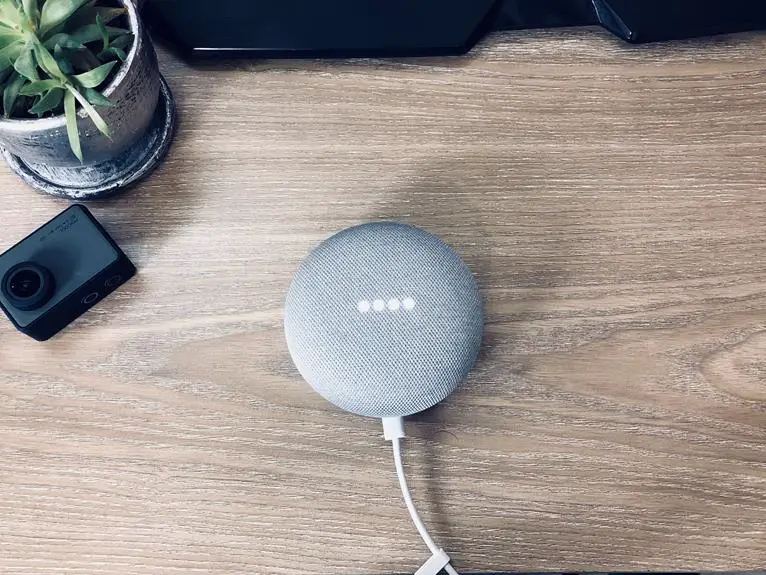Coincidentally, you've found yourself frustrated with the tangled mess of cables in your home office. Achieving safe cable management is crucial for a clean, organized workspace.
By taking the time to identify your cable needs, choosing the right organizers, and utilizing cable clips and ties, you can ensure a safer and more efficient office environment.
This guide will help you create a comprehensive cable management system, allowing you to maintain and update it as needed.
With these strategies, you'll master the art of safe cable management in your home office, eliminating hazards and creating a more productive work space.
Key Takeaways
- Assess home office setup to determine cable needs for devices
- Implement effective cable labeling techniques for easy identification and troubleshooting
- Select appropriate cable organizers based on specific needs of home office setup
- Utilize cable concealment solutions to keep cables neatly tucked away and organized
Identifying Cable Needs
First, assess your home office setup to determine the specific number and types of cables needed for your devices. Start by identifying the various electronic equipment in your workspace, such as computers, printers, routers, and chargers. Take note of the distance between each device and the power outlets or network connections. This will help you assess the length and types of cables required to establish proper connections.
Additionally, consider the specific requirements of each device, such as USB, HDMI, Ethernet, or power cables. Once you have assessed your requirements, it's essential to implement effective cable labeling techniques. Labeling cables not only helps you identify them easily but also aids in troubleshooting and maintenance. Use color-coded labels or cable ties with writable tags to distinguish between different cables. Moreover, consider labeling both ends of the cables for clarity.
Choosing the Right Cable Organizers
How can you effectively store and organize your cables to reduce clutter and enhance safety in your home office?
Choosing the right cable organizers is crucial for maintaining a tidy and hazard-free workspace. There are various cable management products available to help you achieve this, such as cable sleeves, clips, trays, and boxes.
When selecting cable organizers, consider the specific needs of your home office setup. Cable sleeves are great for grouping and concealing multiple cables, while clips and trays can be used for securing and routing cables along walls or under desks. Cable boxes are ideal for managing power strips and excess cords.
Additionally, incorporating effective cable routing techniques can further streamline your cable management efforts. Utilize cable raceways to guide cables along walls or floors, and employ cable ties to bind and organize individual cords.
Organizing Cables Behind Furniture
When organizing cables behind furniture, consider using cable concealment solutions to keep them neatly tucked away and out of sight.
Look for furniture with built-in cable management features to help keep your workspace tidy and free from tangled cords.
Additionally, ensure easy access to power outlets for convenient charging and connectivity.
Cable Concealment Solutions
To conceal cables behind furniture in your home office, consider using cable management solutions designed for discreet organization and safety. When it comes to cable concealment, there are various options to choose from that can help you maintain a tidy and hazard-free work environment.
Here are some effective cable concealment solutions to consider:
- Cable raceways: These are channels that can be mounted on walls or baseboards to hide and protect cables.
- Cable sleeves: Flexible and easy-to-use sleeves that bundle and conceal multiple cables together.
- Cable clips: Adhesive or screw-in clips that keep cables neatly in place along the edge of furniture.
- Cable boxes: Conceal and organize power strips and excess cables inside a sleek box.
- Velcro straps: Reusable and adjustable straps that secure cables and prevent tangling.
Furniture With Cable Management
Organize cables discreetly behind furniture with purpose-built cable management solutions. When selecting furniture for your home office, consider pieces that offer integrated cable organization and storage options to maintain a neat and organized workspace. Here's a comparison table to help you choose the right furniture with cable management features:
| Furniture Piece | Cable Organization Features |
|---|---|
| Desk | Built-in cable trays or grommets |
| Shelves | Cable management clips or channels |
| Credenza | Integrated power strips and cable organizers |
These furniture options provide efficient cable storage, ensuring that your home office remains free from tangled wires and clutter. By investing in furniture designed with cable management in mind, you can create a professional and organized workspace while effectively concealing and organizing cables.
Access to Power Outlets
Position your furniture near power outlets to easily organize and conceal cables behind them. Utilize the following tips to achieve safe and efficient cable management:
- Power strip placement: Opt for a power strip with a long cord to ensure it reaches the nearest outlet without creating cable clutter.
- Cable length: When purchasing cables, ensure they're long enough to reach the power outlets without stretching or causing tangles.
- Surge protector usage: Invest in a surge protector with multiple outlets to accommodate all your devices without creating a jumble of cords.
- Cord organization: Implement cable organizers or clips to keep cords neatly bundled and prevent them from becoming tangled or creating a hazard.
- Accessibility: Ensure that the power outlets are easily accessible, allowing for convenient connection and disconnection of devices without having to move heavy furniture.
Using Cable Clips and Ties
You can easily achieve cable organization by using cable clips and ties.
Keep your workspace neat and tidy while saying goodbye to cable clutter.
With the right tools, you can make cable management in your home office a breeze.
Cable Organization Made Easy
Streamline your cable organization by securing cables with clips and ties for a tidy and safe home office setup. Utilize color coding to easily identify different cables at a glance, reducing the chances of unplugging the wrong one.
Desk grommets offer a sleek solution for routing cables through your workspace, keeping them organized and out of sight. Use adjustable cable clips to hold and manage cables of varying thickness, preventing them from tangling or creating a cluttered appearance.
Velcro cable ties provide a reusable and adjustable option for securing cables, allowing for easy adjustments and additions when needed. Incorporating these simple tools and techniques into your cable management routine won't only enhance the aesthetics of your home office but also contribute to a safer and more efficient workspace.
Neat and Tidy Workspace
Secure your cables using clips and ties to maintain a neat and organized workspace in your home office. By utilizing cable clips and ties, you can effectively manage your cables, maximizing space and reducing distractions.
Start by identifying the optimal placement for your cables and use clips to secure them along the edges of your desk or against the wall. This not only prevents cables from tangling but also creates a tidy appearance.
Additionally, use cable ties to bundle together multiple cords, keeping them organized and out of the way. When your workspace is free from cable clutter, you can focus better on your tasks without being visually overwhelmed.
Implementing these simple solutions will contribute to a more professional and efficient home office environment.
Say Goodbye to Clutter
Maximize organization and minimize visual distractions by utilizing cable clips and ties to effectively manage the cables in your home office. Cable organization is crucial for maintaining a clean and efficient workspace.
Here are some tips to say goodbye to clutter and achieve desk organization:
- Use cable clips to secure and route cables along the edges of your desk.
- Employ cable ties to bundle and streamline multiple cables together, reducing tangling and mess.
- Label cables at both ends for easy identification and maintenance.
- Utilize adhesive-backed cable holders to keep cables in place and prevent them from slipping off your desk.
- Consider using a cable management box or sleeve to hide excess cables and power strips, promoting a clutter-free environment.
Implementing these strategies will help you achieve a neat and organized home office setup.
Managing Power Cords Safely
To manage power cords safely in your home office, organize them using cable ties or clips to reduce clutter and prevent tripping hazards. Cable safety is crucial in preventing accidents and maintaining a tidy workspace.
Start by identifying which cords belong to which devices and then use cable ties to bundle them together. This not only reduces the risk of tripping but also makes it easier to identify and manage individual cords.
Additionally, consider using cable clips to secure cords along the edges of your desk or the wall to keep them out of the way. When setting up your electronics, ensure that power strips and surge protectors are easily accessible and not buried under a tangle of cords.
Labeling cords can also help you quickly identify which cord belongs to which device, making it easier to troubleshoot and maintain your setup.
Creating a Cable Management System
When managing power cords safely in your home office, ensure that you create a cable management system that organizes cords effectively and minimizes tripping hazards. To achieve this, consider the following cable organization tips and tricks:
- Labeling: Use cable tags or labels to identify each cord, making it easier to trace and manage them.
- Cable Ties and Clips: Utilize cable ties and clips to bundle and secure cords, preventing them from tangling or creating clutter.
- Cable Sleeves: Invest in cable sleeves to conceal and protect cords, providing a neat and streamlined appearance.
- DIY Solutions: Explore creating custom cable management solutions using everyday items like binder clips or PVC pipes to organize and route cords discreetly.
- Cable Management Boxes: Consider using cable management boxes to store excess lengths of cords and power strips, maintaining a tidy workspace.
Maintaining and Updating Cable Organization
You can maintain and update cable organization by regularly inspecting and reorganizing your cords to prevent hazards and maintain efficiency. Implementing cable labeling techniques can be a game-changer in keeping your cords organized.
Use color-coded labels or cable ties with built-in labels to easily identify and trace each cord. This not only helps in preventing mix-ups but also simplifies troubleshooting and maintenance.
In addition to labeling, utilizing the right cable management tools is crucial for keeping your setup tidy and safe. Cable clips, cable trays, and cable sleeves are great tools for bundling and concealing cords, preventing them from tangling or becoming trip hazards.
Cable trays can be mounted under desks or along walls to keep cables off the floor and out of sight. Cable sleeves provide a neater and streamlined appearance by bundling multiple cords together.
Regularly incorporating these cable labeling techniques and cable management tools into your routine will ensure that your home office remains organized, efficient, and safe.
Frequently Asked Questions
What Are Some Common Safety Hazards Associated With Poorly Managed Cables in a Home Office?
When cables are poorly organized, common safety hazards arise in your home office. Proper cable maintenance and storage are essential to prevent tripping, electrical fires, and equipment damage. Prioritize cable organization for a safe workspace.
How Can I Prevent My Cables From Becoming Tangled or Damaged Over Time?
To prevent tangling and protect your cables, maintain durability by organizing them efficiently. Use cable management tools like clips, sleeves, and cable ties. Keep cables away from high-traffic areas and secure them to surfaces to minimize wear and tear.
Are There Any Specific Considerations for Managing Cables in a Home Office With Pets or Children?
For safety precautions in your home office, consider cable concealment to pet-proof and child-friendly solutions. Use cord covers, cable sleeves, or cable clips to keep cables out of reach from pets and children.
What Are Some Tips for Organizing Cables in a Home Office With Limited Space or Unconventional Furniture Arrangements?
When organizing cables in a cramped home office, prioritize cable organization and consider space-saving solutions. Use cable clips or trays to keep them neat and out of the way, and opt for wireless devices where possible.
How Can I Future-Proof My Cable Management System to Accommodate New Technology or Devices?
To future-proof your cable management system for new technology and devices, integrate versatile cable organization solutions to accommodate future needs. Optimize space and consider adjustable cable management options to ensure seamless technology integration.





